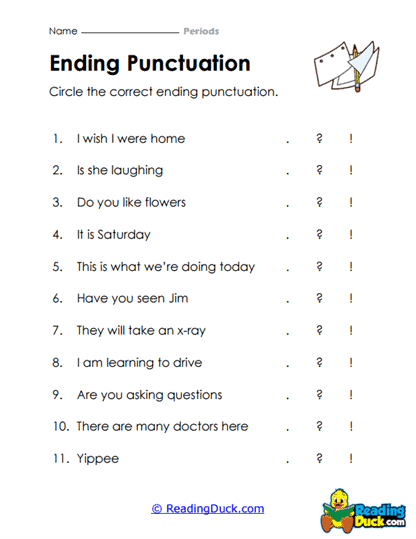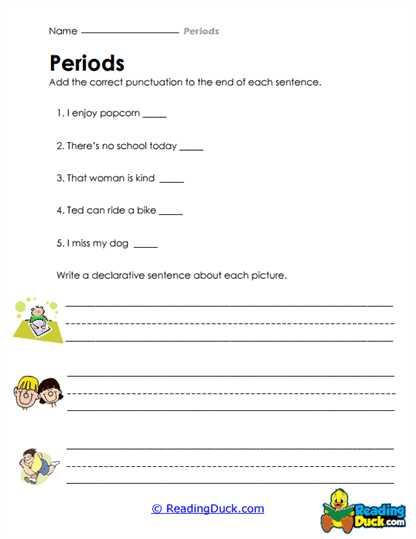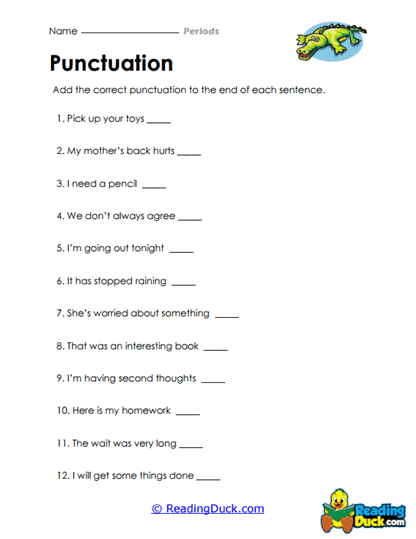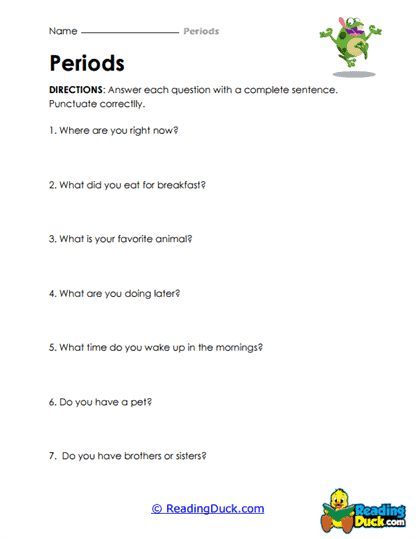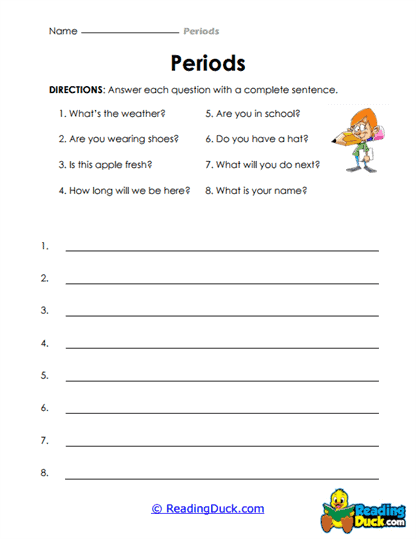Periods Worksheets
About Our Period Worksheets
The Periods Worksheets collection is part of the Punctuation category within the Skills section, designed to help students master the use of one of the most fundamental punctuation marks: the period. These worksheets introduce students to the rules governing the use of periods, explaining their role in ending sentences, abbreviating words, and clarifying meaning in writing. By working through these worksheets, students strengthen their understanding of how periods contribute to sentence structure, readability, and clarity in written language.
Presented in a convenient PDF format, these worksheets are easy to view, download, and print, making them adaptable for both classroom and home use. Each worksheet also comes with a downloadable answer key, ensuring that students can check their progress and educators can easily facilitate discussions about the correct use of periods. This approach encourages independent learning while reinforcing the rules of punctuation.
What Are Periods and Why Are They Important?
Periods, though simple, play a crucial role in written communication. They are small punctuation marks placed at the end of declarative sentences, imperative sentences, and sometimes after abbreviations. Understanding how and when to use periods is essential for students as they develop the ability to structure coherent and complete thoughts in writing. Let's explore the significance of periods in a structured way:
Defining Periods: A period is a dot (.) that is placed at the end of a complete sentence. Its primary function is to signal the end of a thought or statement, allowing the reader to pause before moving on to the next sentence. Periods create clear divisions between ideas, making the text easier to read and follow.
Where Periods Are Used:
-
- End of Declarative Sentences: Periods are used to end sentences that state a fact or make a statement. For example:
The sky is blue. - End of Imperative Sentences: When a command or request is given, a period is used at the end of the sentence. For instance:
Please close the door. - Abbreviations: Periods are often used to shorten words through abbreviations, helping to make writing more concise. For example:
Dr. (for Doctor) or etc. (for et cetera).
- End of Declarative Sentences: Periods are used to end sentences that state a fact or make a statement. For example:
The Role of Periods in Sentence Structure: Periods are vital for organizing sentences in a clear and structured way. Without periods, writing becomes difficult to understand because ideas may blur together. By marking the end of each sentence, periods signal to the reader that a thought has been completed, allowing them to pause and process the information before moving on.
Examples of Period Usage:
- Correct Usage:
-
- She walked to the park.
- The meeting is scheduled for 10 a.m.
-
- Incorrect Usage:
-
-
- She walked to the park the meeting is scheduled for 10 a.m (missing periods result in a confusing run-on sentence).
-
How Periods Are Used in Different Contexts
Periods serve multiple purposes in writing, each contributing to clear communication. Understanding these various uses helps students apply periods accurately in different contexts. Below are the main functions of periods, explained with examples:
Ending a Sentence: The most common use of a period is to mark the end of a declarative or imperative sentence. This signals the completion of an idea and provides a natural pause for the reader. For example:
-
- The concert starts at 7 p.m.
Abbreviating Words: Periods are essential in forming abbreviations, which shorten words or phrases without changing their meaning. This is often seen in titles, time, and certain common expressions. For example:
-
- Mr., Ms., Ave., i.e., a.m., p.m.
Ellipses (...): A series of three periods, called an ellipsis, is used to indicate a pause or the omission of words in a quote. While this is technically a separate function from the period at the end of a sentence, it still involves the use of the period symbol. For example:
-
- "He said he would come...but I’m not sure when."
In Numbers and Money: Periods also appear in numerical contexts, such as in decimal points and monetary values. For instance:
-
- The item costs $5.99.
By mastering these different functions of periods, students can communicate more effectively across various types of writing, from everyday sentences to more complex technical or formal texts.
How Mastering Periods Contributes to Literacy
Periods are essential in the development of strong literacy skills. Learning how to properly use periods helps students become more confident readers, writers, and speakers. Here’s how mastering this punctuation mark contributes to overall literacy:
- Improved Reading Comprehension: When students understand the role of periods in marking the end of sentences, they can read with better fluency. Knowing where sentences begin and end allows them to follow the flow of ideas more clearly, leading to better comprehension of the text.
- Stronger Writing Skills: The proper use of periods leads to clearer, more structured writing. Students who understand where to place periods can avoid run-on sentences and fragments, ensuring that their ideas are communicated effectively. This skill is critical for all forms of writing, from creative stories to academic essays.
- Enhanced Public Speaking: Understanding how periods function in writing translates to better oral communication. Periods help students recognize where natural pauses occur in speech, improving their ability to speak clearly and with appropriate emphasis.
Interactive Learning Activities for Periods
To reinforce the concepts covered in these worksheets, educators can incorporate engaging and interactive activities into their lessons. These activities work well in both classroom settings and homeschool environments and are suitable for students in grades 2 to 5, depending on the complexity of the task.
- Sentence Completion Challenge: Provide students with incomplete sentences, asking them to add the appropriate punctuation, including periods. This activity helps reinforce the placement of periods and how they signal the end of a thought.
- Abbreviation Match Game: Create a game where students match common abbreviations (e.g., Mr., Dr., a.m.) to their full forms. This activity emphasizes the use of periods in abbreviations while also enhancing students’ vocabulary.
- Spot the Period: In this activity, students are given a short passage with all punctuation removed. Their task is to insert periods where necessary to clarify the meaning of the sentences. This helps students practice identifying where a thought ends and where a period should be placed.
- Period Practice in Numbers: For more advanced students, provide exercises that involve periods in monetary values or decimal numbers. This reinforces their understanding of periods in a numerical context, expanding their practical punctuation skills.
- Write and Share: Encourage students to write short stories or personal narratives, paying special attention to where they place their periods. After writing, students can share their stories with the class, explaining why they placed their periods where they did.
The Significance of Periods in Writing
In conclusion, periods are a foundational aspect of punctuation that all students must master to become proficient writers. These small but powerful marks control the flow of sentences, ensure clarity, and help communicate complete thoughts in writing. By understanding the rules governing the use of periods, students can avoid common errors such as run-on sentences and sentence fragments, resulting in clearer and more effective communication.
The Periods Worksheets collection provides a structured way for students to develop this critical skill. Through engaging exercises and activities, students learn how to place periods correctly in sentences, use them in abbreviations, and recognize their role in other contexts, such as numbers. As students practice using periods, they build confidence in their writing abilities, laying the foundation for more advanced literacy skills that they will use throughout their education and beyond.

